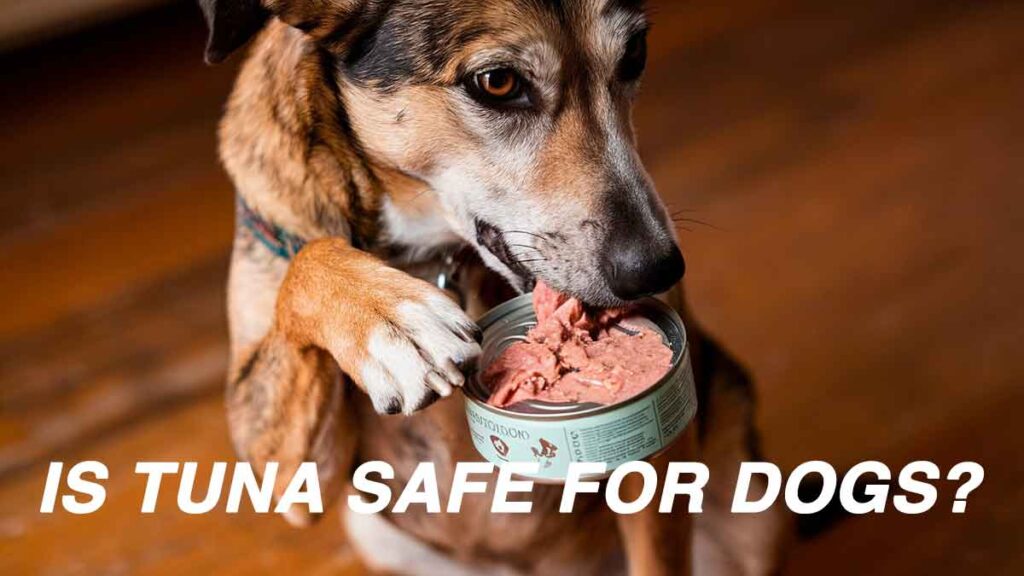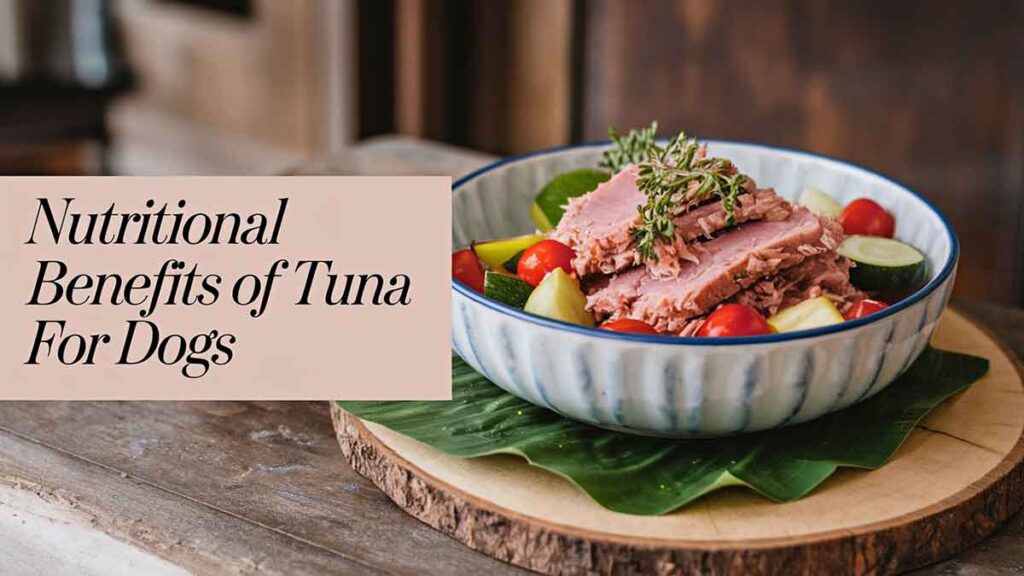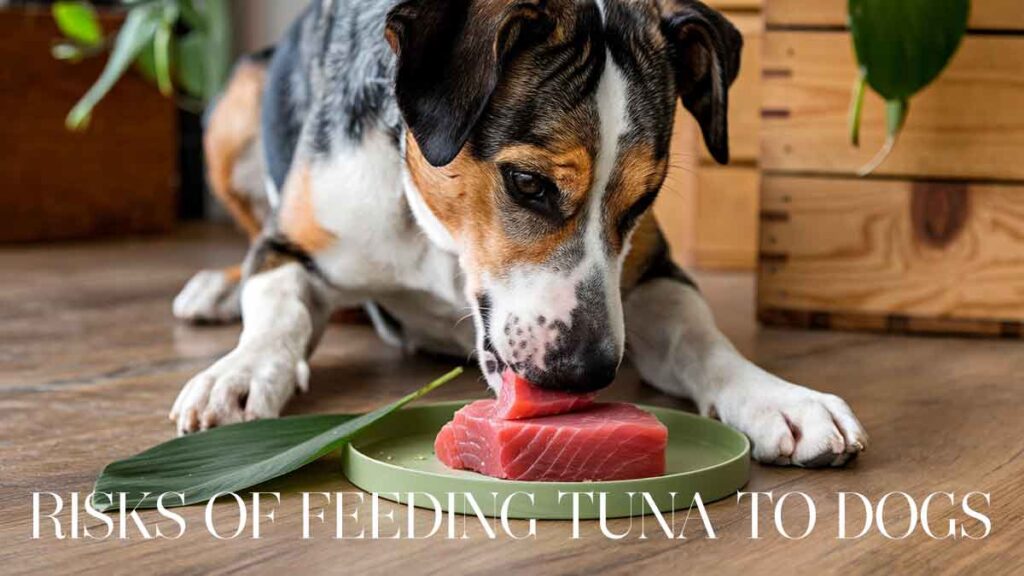If you’ve ever asked yourself, “Can dogs eat tuna?” you’re not alone! This common question crosses the minds of many dog owners when they see their furry friend eyeing a tasty piece of fish. The short answer is, yes, dogs can eat tuna, but only in moderation and under specific conditions. In this article, we’ll dive deep into everything you need to know about feeding tuna to dogs, including the potential benefits and risks, how to safely serve it, and some alternative options to consider.
Is Tuna Safe for Dogs?Can Dogs Eat Tuna?

Regarding feeding tuna to dogs, safety should be your top priority. While tuna itself is not toxic to dogs, there are several aspects to consider before offering it to your pet:
- Mercury Levels: Tuna, especially larger species, can contain high levels of mercury. This heavy metal can accumulate in your dog’s body over time, potentially leading to mercury poisoning. Symptoms include vomiting, diarrhoea, tremors, and even neurological damage. To avoid this, it’s crucial to keep portions small and infrequent.
- Sodium Content: Many types of canned tuna are preserved with added salt, which can lead to excessive sodium intake in dogs. High sodium levels can cause increased thirst, frequent urination, and, in severe cases, sodium ion poisoning. Always opt for tuna packed in water with no added salt.
- Allergic Reactions: Dogs can develop aversions to any food, including tuna. If your dog has never eaten tuna, introduce it bit by bit and watch for indications of narrow-mindedness, such as itching, vomiting, or diarrhoea. Vsit this Link pawlicy
Key takeaway: While tuna can be safe for dogs, it should be given sparingly and always under the guidance of a veterinarian.
Nutritional Benefits of Tuna for Dogs

Tuna is delicious and highly nutritious for dogs when given in the right amounts! Below is a detailed breakdown of some of the main benefits that this fish can offer to your furry friend:
- Lean Protein
Fish is a fabulous wellspring of slender protein, fundamental for canine muscle development and fix. This high-quality protein provides the amino acids necessary for building and maintaining muscles, supporting energy production, and aiding cell regeneration. Lean proteins are ideal for active dogs or those recovering from illness, as they promote tissue repair without adding extra fat to their diet.
- Why Lean Protein Matters: Proteins are critical for dogs because they are vital in maintaining a healthy metabolism, producing hormones, and supporting the immune system.
- Practical Tip: For a protein boost, consider adding a small amount of cooked tuna (free from any added salt or seasoning) to your dog’s food.
- Omega-3 Fatty Acids
Omega-3 fatty acids found in fish are major fats that offer a wide assortment of clinical benefits:
- Improved Coat and Skin Health: Omega-3s assist with keeping your canine’s jacket sparkly and skin sound. They lessen irritation and dryness, which makes them especially important for canines with awarenesses or skin conditions.
- Anti-Inflammatory Properties: Omega-3s can reduce inflammation in joints and tissues, making them beneficial for senior dogs or those with arthritis or other joint issues.
- Enhanced Cognitive Function: These fatty acids support brain health and cognitive development in puppies and help maintain cognitive function in adult and senior dogs.
Omega-3 fatty acids have also been shown to improve cardiovascular health by reducing cholesterol levels and supporting heart function. Adding omega-3s to your dog’s diet can keep their coat looking vibrant and reduce the risk of inflammatory diseases.
- Essential Vitamins and Minerals
Tuna is rich in several vital vitamins and minerals that support your dog’s overall well-being, including:
- Vitamin B12 is critical for keeping a solid sensory system and creating red platelets. A deficiency in vitamin B12 can lead to anaemia and neurological issues in dogs.
- Vitamin D: Supports bone wellbeing and manages calcium and phosphorus levels, areas of strength for guaranteeing and teeth.
- Selenium: A powerful antioxidant that protects cells from free radical damage, boosting your dog’s immune function and thyroid health.
- Iodine: Essential for thyroid function, which regulates metabolism and influences weight control, energy levels, and overall health.
These vitamins and minerals work synergistically to promote optimal dog health, support a healthy immune system, and boost energy levels.
- Low-Fat, High-Protein Alternative
Tuna is a low-fat, high-protein option, making it a fantastic choice for canines that need to maintain a sound weight. Lean proteins like tuna are ideal for dogs with dietary restrictions or who need to avoid high-fat foods.
- Weight Management: Tuna’s low-fat profile makes it perfect for dogs on a weight-control diet. It provides essential nutrients without contributing to unhealthy weight gain.
- High in Taurine
Taurine is a fundamental amino acid that supports heart health and vision. While canines can integrate taurine from other amino acids, certain breeds may benefit from additional taurine in their diet. Tuna naturally contains taurine, which can help dogs, especially those prone to cardiovascular diseases.
Despite these impressive benefits, it’s crucial to remember that the nutrients in tuna can also be found in other fish and protein sources without the risks associated with tuna. Feeding tuna in moderation is essential to avoid mercury poisoning and sodium overload. Rotate different protein sources to ensure your dog’s diet is balanced, varied, and safe.
Risks of Feeding Tuna to Dogs

While tuna can offer several nutritional benefits, it’s important to understand the significant risks it poses if fed improperly or too frequently. Let’s break down the key dangers of feeding tuna to dogs and why moderation is crucial.
- Mercury Poisoning
One of the most critical dangers of feeding tuna to dogs is the risk of mercury poisoning. Mercury builds up in fish, making it a harmful, weighty metal. Larger fish species like tuna have higher concentrations than smaller fish such as sardines or mackerel.
- How Mercury Accumulates: Mercury is introduced into the ocean through industrial pollution and becomes part of the marine food chain. Because tuna are large, predatory fish, they accumulate high levels of mercury as they feed on smaller fish over their lifetime.
- Impact on Dogs: When dogs consume too much tuna, mercury can build up in their bodies, causing symptoms like vomiting, diarrhoea, tremors, and loss of coordination. Drawn-out openness can prompt serious medical problems, such as kidney harm and neurological issues. In severe cases, it can even result in blindness or death.
Practical Tip: Limit your dog’s tuna intake to small portions once or twice a month to prevent mercury toxicity. Choosing smaller tuna species like skipjack can be safer because they have lower mercury levels than larger species like yellowfin or bluefin tuna.
- Sodium Overload
Many canned tuna products contain added salt to preserve flavour and shelf life. Excess sodium intake can be harmful to dogs.
- Why High Sodium is Dangerous: Excessive sodium can cause dehydration, increased thirst, and frequent urination. It can also lead to sodium ion poisoning, which manifests through symptoms like vomiting, diarrhoea, tremors, and, in severe cases, seizures or death.
- Choosing the Right Tuna: When feeding your dog canned tuna, always choose tuna packed in water with no added salt. Avoid tuna packed in oil or flavoured with additional seasonings, as they can further upset your dog’s stomach and contribute to weight gain.
Pro Tip: If you’re concerned about sodium content, rinse the canned tuna with fresh water before feeding it to your dog. This helps reduce sodium while allowing your dog to enjoy a small portion of tuna.
- Physical Hazards
Another risk to be aware of is the potential for physical injuries caused by feeding dogs certain parts of the tuna fish.
- Raw Tuna: Feeding dogs raw tuna can expose them to parasites and bacteria such as Salmonella and Listeria. These harmful organisms can cause gastrointestinal issues and infections, leading to severe health problems. Raw fish likewise contains a compound called thiaminase, which separates thiamine (vitamin B1) and can result in a thiamine deficiency in dogs.
- Bones and Skin: Tuna bones are small and sharp, making them a potential choking hazard or a cause of injuries in your dog’s digestive tract. Swallowed bones can also lead to oesophagal or intestinal blockages, which can be perilous if not treated expeditiously.
- Head and Tail Parts: These parts of the fish should never be fed to dogs as they can cause oral injuries and increase the risk of intestinal perforation.
Pro Tip: Always ensure that any tuna you feed your dog is fully cooked, deboned, and free of harmful parts. Cooked tuna should be prepared without spices, oils, or additives that could harm your dog’s health.
How to Feed Tuna to Dogs Safely
To ensure your dog enjoys tuna without any health risks, follow these guidelines:
- Opt for Canned Tuna in Water – Choose tuna canned in water with no added salt or seasonings. Avoid tuna packed in oil, as it adds unnecessary fats that can lead to digestive upset or weight gain.
- Serve in Small Portions – Limit servings to small amounts, such as a teaspoon or two for small breeds and a tablespoon or two for larger breeds. Feed tuna no more than once or twice a month.
- Cook Fresh Tuna Properly – If you’re using fresh tuna, steam, bake, or grill it without any seasonings. Ensure it’s thoroughly cooked and deboned before offering it to your dog.
- Monitor Your Dog’s Reaction – When feeding tuna for the first time, notice your canine for any indications of a hypersensitive response, like tingling, vomiting, or diarrhoea. If you notice any symptoms, discontinue feeding and consult your vet.
Can Dogs Eat Canned Tuna?
Yes, dogs can eat canned tuna, but with specific considerations. Canned tuna should only be given occasionally, and you should always choose the variety packed in water without added salt or flavours. This reduces the risk of sodium overload, which can be risky for canines whenever consumed in overabundance.
Small Species of Tuna are Safer: Assuming you’re worried about mercury levels, settle on more modest fish species like skipjack or tuna. These species will generally have lower mercury fixations than bigger species like yellowfin. or bluefin tuna.
Alternatives to Tuna for Dogs
If you’re looking for safer fish options for your dog, consider the following alternatives:
- Salmon: Rich in omega-3 fatty acids, cooked salmon is a fantastic option that provides benefits similar to tuna without high mercury content.
- Sardines: These small, oily fish are low in mercury and high in beneficial nutrients like calcium and vitamin B12.
- Whitefish (Cod, Haddock): Lean and easy to digest, whitefish is an excellent source of protein with minimal health risks.
- Chicken and Turkey: For non-fish alternatives, lean meats like chicken and turkey offer high-quality protein without the risk of mercury or excessive sodium.
FAQ Section
Q1: Can dogs eat tuna every day?
A1: Dogs should not eat tuna daily due to its high mercury content. Stick to small portions once or twice a month to avoid health risks.
Q2: What kind of tuna can dogs eat?
A2: Dogs can eat canned tuna in water without added salt or fresh, cooked tuna without spices or seasonings. They should avoid tuna in oil or with added flavours.
Q3: Is tuna good for a dog’s coat and skin?
A3: Yes, the omega-3 fatty acids in tuna can help improve a dog’s coat and skin health, but feed it sparingly to prevent mercury accumulation.
Q4: Can puppies eat tuna?
A4: It’s best to avoid feeding tuna to puppies due to their smaller size and higher sensitivity to mercury and sodium. Consult your vet before introducing fish into a puppy’s diet.
Q5: What happens if dogs eat too much tuna?
A5: Consuming too much tuna can lead to mercury or sodium poisoning in dogs, with symptoms such as vomiting, diarrhoea, and lethargy. Seek veterinary assistance if you suspect your dog has eaten too much tuna.
Conclusion: Can Dogs Eat Tuna?
So, can dogs eat tuna? The answer is yes, but it must be done with caution. Tuna can be a healthy dog treat when served in moderation and prepared correctly. It’s a rich source of lean protein, omega-3 unsaturated fats, and fundamental nutrients like B12 and D. It contributes to a dog’s overall health, supporting muscle growth, a shiny coat, and cognitive function.
However, the potential risks, such as mercury poisoning, sodium overload, and physical hazards from bones or parasites in raw tuna, mean that this fish should only be given sparingly. Smaller tuna species (like skipjack) or canned tuna in water with no added salt are safer choices. To ensure your dog reaps the benefits of tuna without the negative effects, offer it no more than once or twice a month and monitor for any signs of adverse reactions.
If you’re ever in doubt, consider safer alternatives like salmon, sardines, or other lean protein sources that provide similar nutrients without the health risks associated with tuna. As always, please consult your veterinarian before significantly changing your dog’s diet to ensure it aligns with their health needs and dietary requirements.
